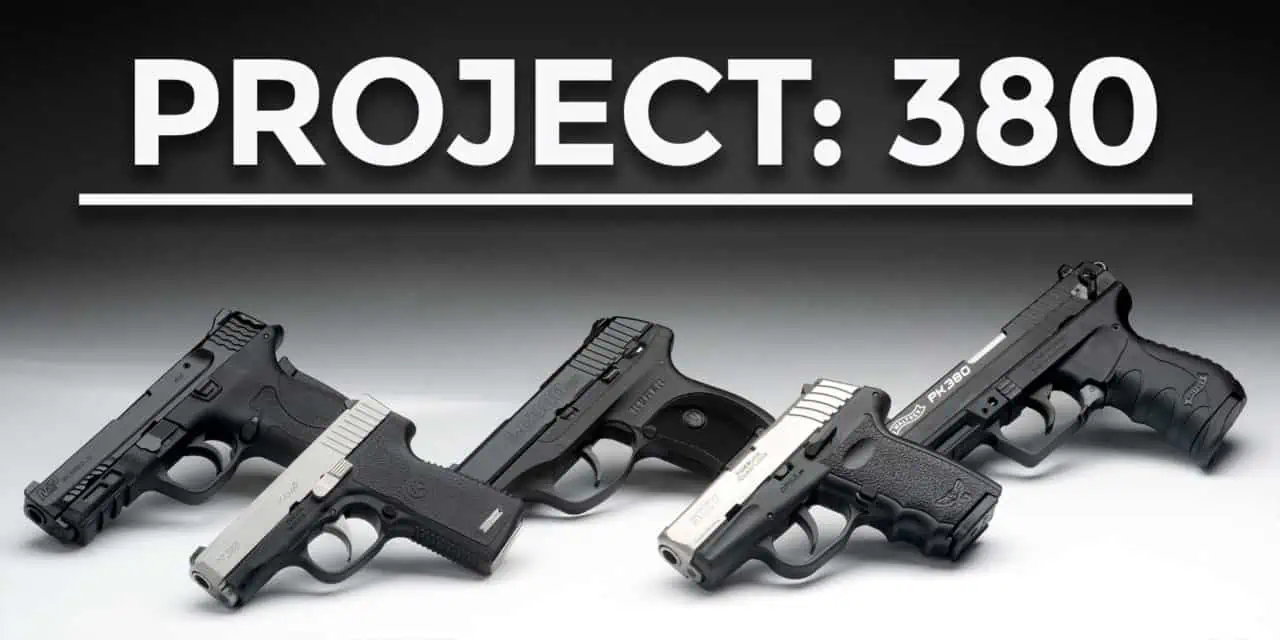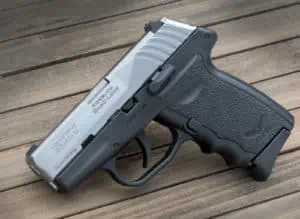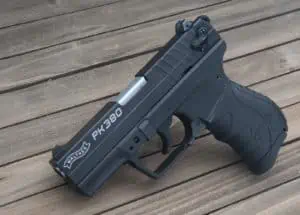Project 380: The Best Compact 380 Pistol
Over the past ten years or so, there have been two interesting trends develop in defensive pistols.
The first is the rise of the pocket-sized .380 pistol, epitomized by guns like the Kel-Tec P3AT and the Ruger LCP.
The second is the rise of the single stack or subcompact 9mm pistol, like the Smith & Wesson M&P Shield and the Glock 48.
Its easy to see why these two types of guns are so popular. They’re small, lightweight, and easy to carry, yet they have enough firepower to keep you safe when things get dicey. But neither type is perfect. If you carry a pocket .380, you can have a gun with you pretty much anywhere you go. This is due to the pocket .380’s small size compared to that of the generally bigger and heavier 9mm subcompact. But, you’re giving up a significant advantage in magazine capacity and penetration.
The 9mm subcompact has a significant edge in firepower over the pocket .380, but the added size and weight can make it impractical to carry in some situations. Some 9mm subcompacts can also be difficult to shoot. Recognizing the limitations of both the pocket .380 and the subcompact 9mm, gun manufacturers sought to develop a gun that had the best of both worlds. This led them to develop the compact .380 pistol.
In this article, we’ll take a look at the compact .380 to see if it is a legitimate option for concealed carry. We’ll also test several compact .380 models to see if one stands out from the crowd.
Why Choose A Compact 380 Pistol?
Popular compact .380 models include the Walther PK380 and Ruger LC380. They are about the same size as a subcompact 9mm, but they fire the lower-powered .380 ACP round common to pocket pistols. At first glance, these pistols don’t seem to make a lot of sense. If you can carry around a 9mm Ruger LC9, why would you want to carry a similarly-sized Ruger LC380 that shoots a lower-powered .380 ACP cartridge?
Sometimes, Less Is More
My current choice in carry guns is a 9mm S&W Shield. I carry mine on my hip in a Blade-Tech holster. I’ve carried this gun for about a half- dozen years now. While it’s been a proven performer for me, something interesting happened on a recent shooting outing with my father. My dad, in his mid-70s, just couldn’t summon the strength to grasp the slide of my Shield and pull it back to charge the gun. He was fine with the recoil and could shoot the gun once I got it rolling for him, but getting into battery after emptying a magazine was too much for him.
This mirrored my experience working in a gun shop here in Florida. When people came into the store looking for a defensive pistol, we’d initially steer them toward something like a Glock 19. But many retirees found those guns difficult to operate. They were also hesitant about the long, stiff trigger on most defensive revolvers. As a result, many of them ultimately settled on the Sig Sauer P238 because (a) it’s small and cute, (b) it comes in a rainbow of colors, and (c) they could operate all the controls on it much easier than they could on a Glock 19. Would that gun be my first choice for a defensive pistol? No. Was it a bad choice for my customers? Considering that I saw a fair number of them return to the range to practice with their new guns, I’d say they made the correct choice.
Compact 380s: “Marginally Effective” Doesn’t Mean “Ineffective”
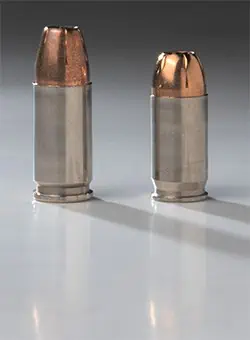
9x19mm vs. 9x17mm: That 2mm makes a big difference.
Compact .380 pistols, like the ones in our test, are not the best choice for a self-defense pistol. The .380ACP round is marginally effective as a defensive cartridge. It is underpowered compared to 9mm or other common defensive rounds, and as such, it struggles to meet FBI ballistics standards.
However, that doesn’t mean that .380ACP is an ineffective defensive round. All of the pistols in our tests were easily capable of placing their shots inside of a 6-inch circle at 15 yards. This means that if the shooter can make the shot, they can make it with any of these pistols.
Also, on average, all of these pistols require less physical effort than a compact 9mm. We tested a Glock 19 using the same scales we used for slide effort and trigger pull to see how it would compare with these guns. At over 26 pounds of effort for the slide and a 6.75 average trigger pull, a Glock 19 would need more physical strength to manipulate the basic controls of the pistol than either that either the Ruger LC380, Shield 380EZ or the Walther PK380.
Let’s take a look once more at the strengths and weaknesses of each gun in our test, and see what judgement calls we make.
Strengths: Capacity, Price, Small Size, Slide Effort
Weaknesses: Reliability, Trigger
With it’s 10+1 capacity and small size, the Sccy packs a lot of punch into a compact .380 package. However, the trigger on the pistol is quite stubborn, and you’ll need to make sure your magazines work well with your gun.
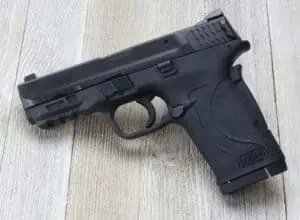 Smith & Wesson M&P Shield 380EZ
Smith & Wesson M&P Shield 380EZ
Strengths: Trigger, Slide Effort, Reliability
Weaknesses: Large Size
Accurate, reliable and easy to use, the 380EZ is a top performer in this class. Carrying it daily may require more changes in lifestyle than other guns on this list, but if you’re looking for an easy to use home defense pistol, look in this gun’s direction.
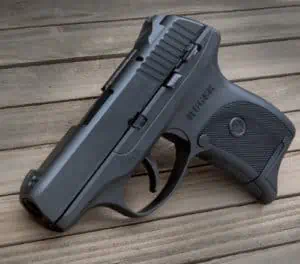 Ruger LC380
Ruger LC380
Strengths: Concealability
Weaknesses: Reliability with hollow points
One of the first-movers in this field, the LC380 turned in a solid performance in every area of our tests. If you’re concerned about your ability to manage the recoil of a 9mm, and need a gun to protect at home and when you’re out and about, try the LC380 on for size.
Walther PK380
Strengths: Slide Effort, Trigger Pull, Accuracy
Weaknesses: Large Size, Ergonomics
The Walther is a gun that I really, really wanted to like, and with a great trigger, easy-to-rack slide and best-in-class accuracy, the only thing that’s holding me back from liking it a lot is the unusual operation of it’s manual safety.
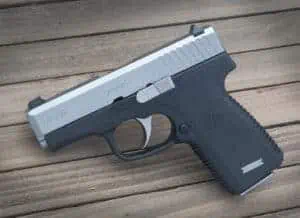 Kahr CT380
Kahr CT380
Strengths: Small Size, Concealability
Weaknesses: Slide Effort
One step up in size from a pocket pistol, the Kahr feels great in the hand, which is not surprising, considering Kahr’s long history of producing quality compact pistols. The Kahr is a good choice for people who need a little something to keep them safe on the road, and then also serve as a home defense pistol as well.
Final Thoughts
While .380ACP may not be everybody’s first choice in a defensive pistol, it’s been proven to be effective when used correctly when it counts. Choose your pistol, then choose your ammo, and above all, make the decision to practice regularly and improve your ability to make the shot on-demand and under pressure. A pistol is not a security blanket: They are not there to make you FEEL safe, there are there to make you BE safe, so be ready to use them if needed.
What do you think? Did we get it right? Sound off in the comments below!

